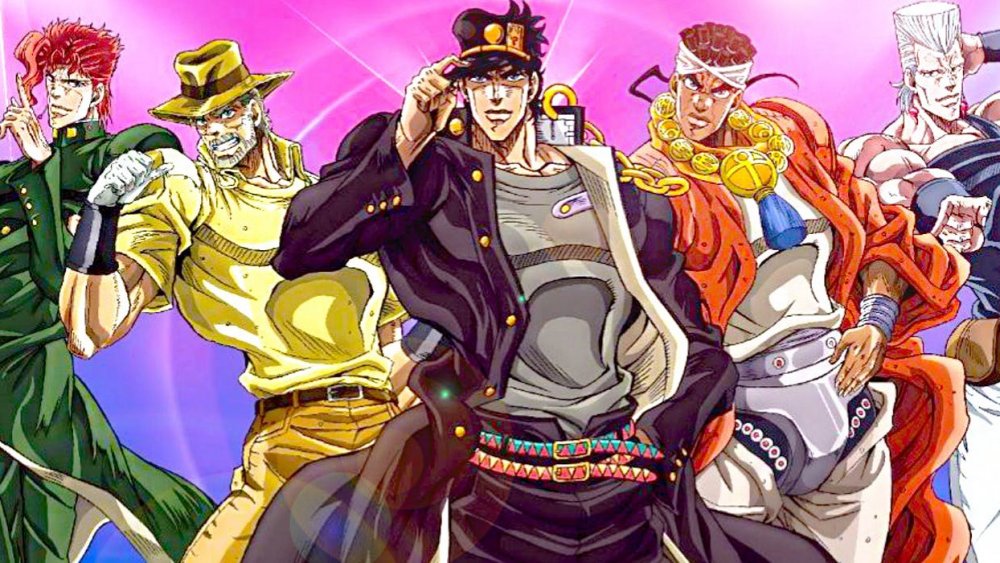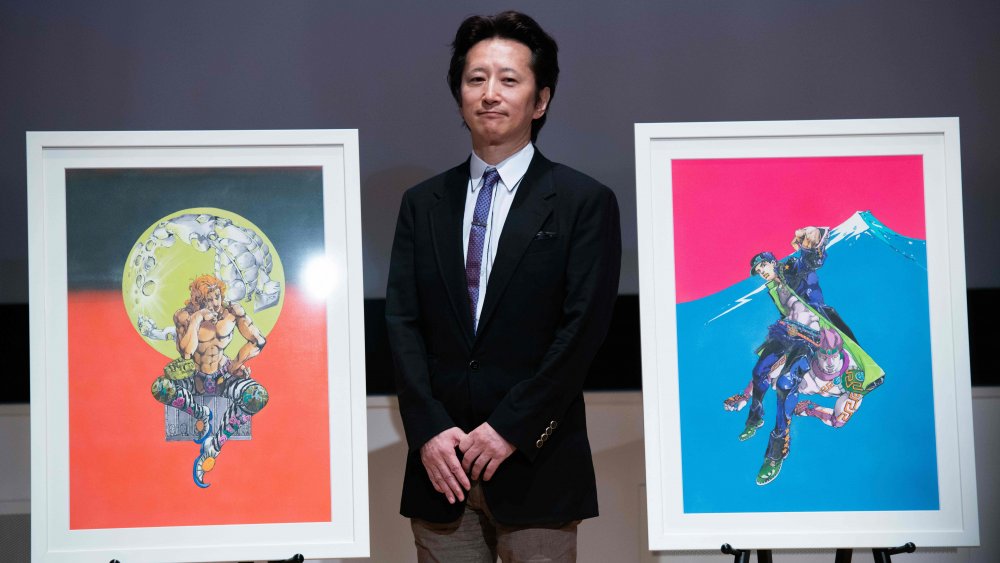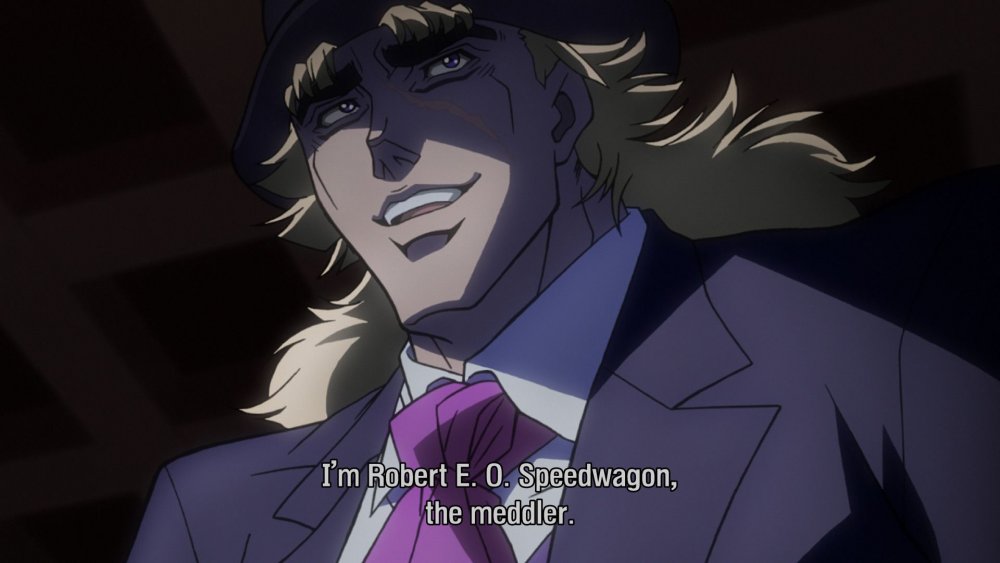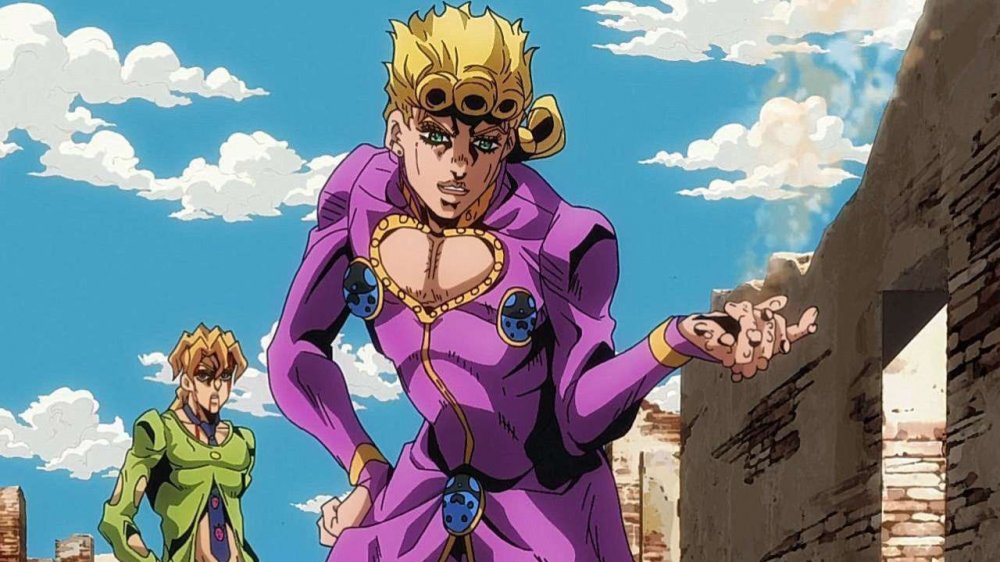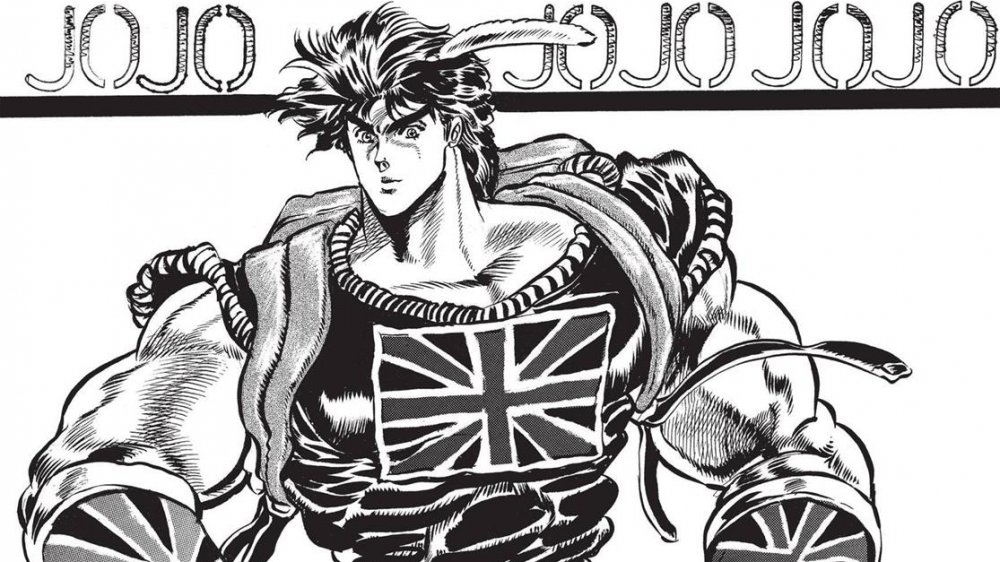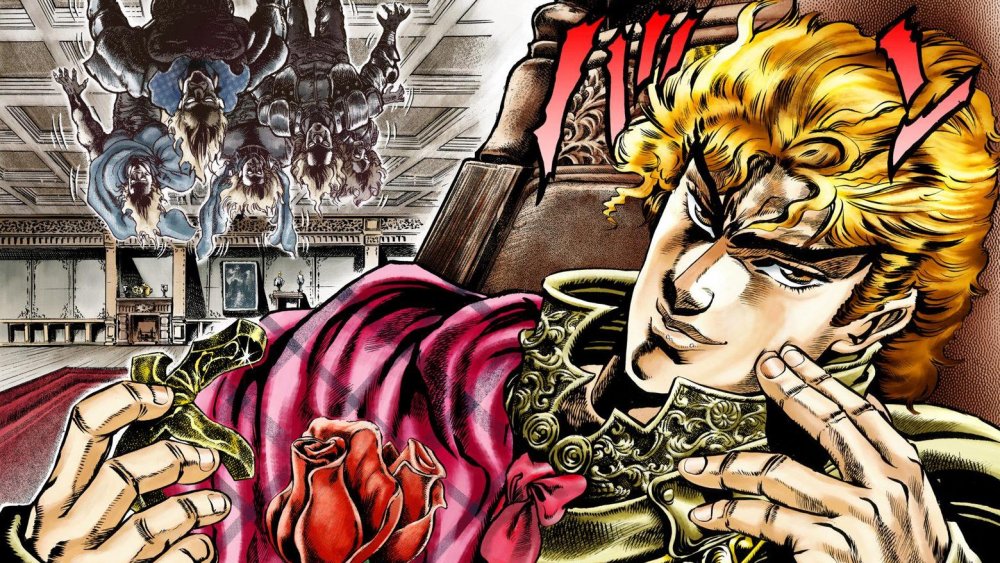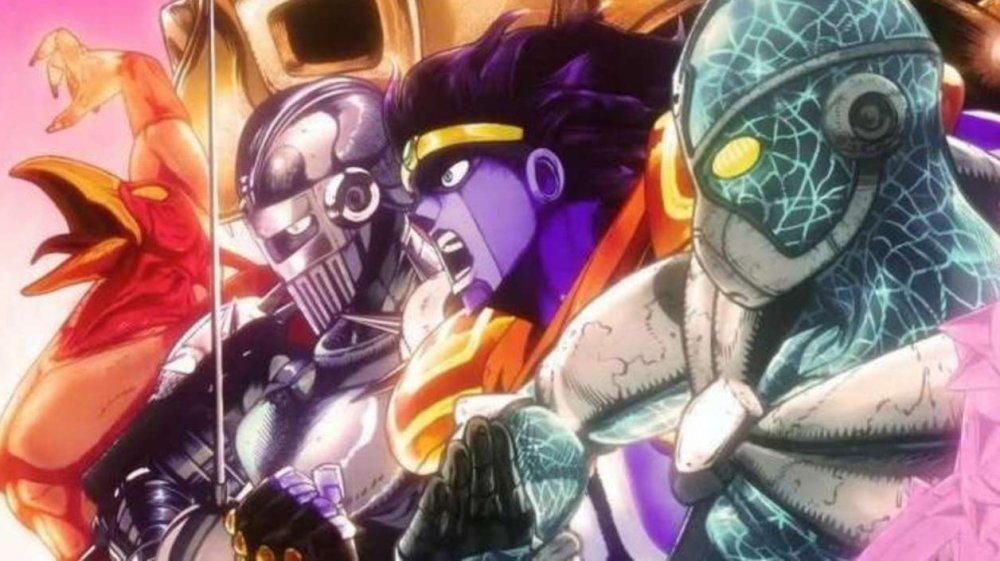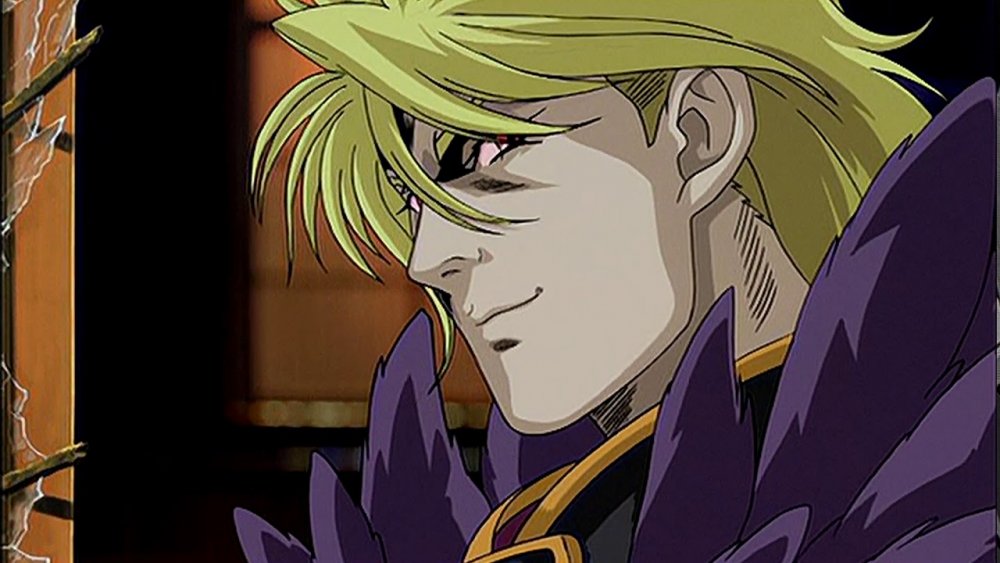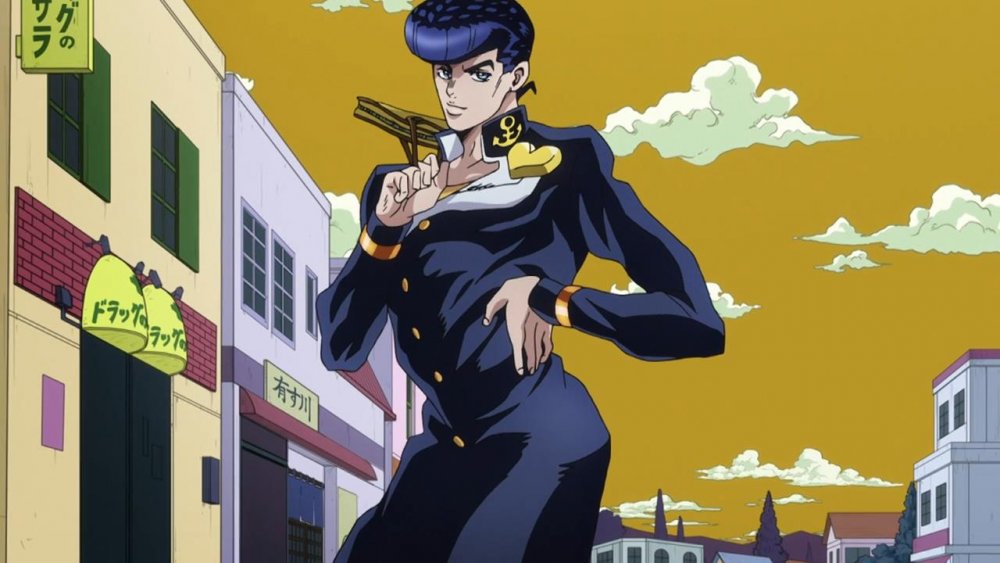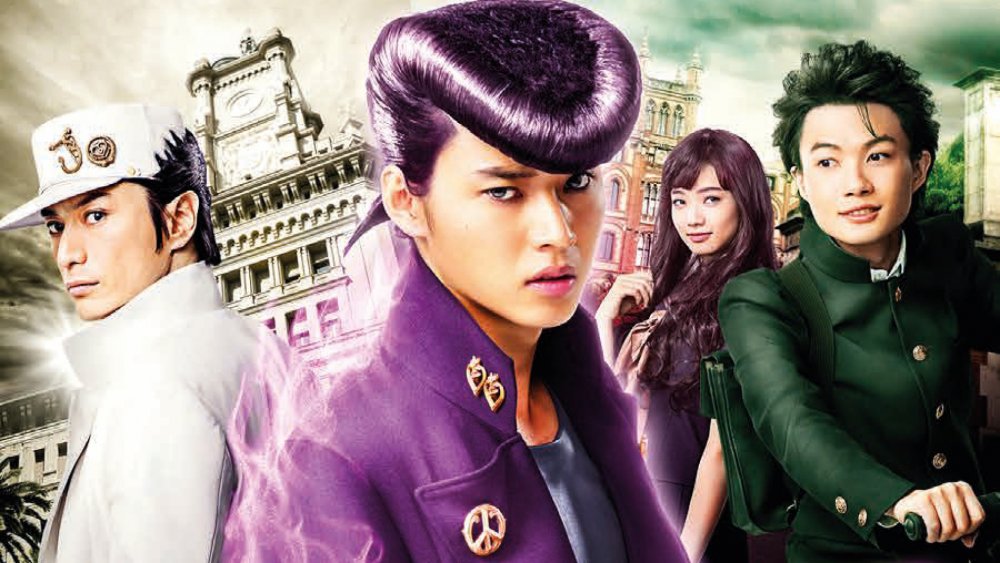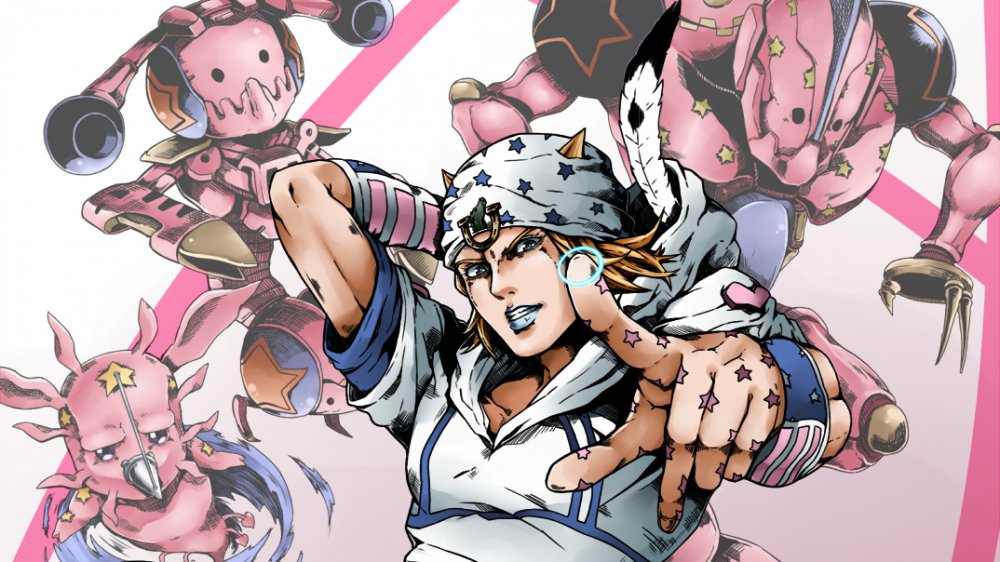The Untold Truth Of JoJo's Bizarre Adventure
If you have at least a tangential knowledge of manga and anime, you've heard of Hirohiko Araki's JoJo's Bizarre Adventure. You might have been intimidated by its length (a common manga problem) since it's been ongoing since 1987. Not to mention, the story it tells spans far more time than that. JoJo isn't just one hero. It's an entire bloodline of heroes, all of whom have a name that can be shortened, more or less, to "JoJo." Each section of the story is set in a different time period and stars a different JoJo.
The JoJos tend to be charismatic outsiders, although they often gather teams around them as they set out on their quests. All of them also gain some form of supernatural powers, although the nature of those powers (as well as just how powerful they are) shifts dramatically when the series jumps from 1938 to 1988... but we'll get to that. There is a strong "good versus evil" aspect to the stories, although the morality can also be complex. The JoJos are usually chaotic and sometimes even criminal, but the villains tend to be embodiments of pure evil, so it's never hard to figure out who to root for.
Hirohiko Araki, JoJo's creator
Hirohiko Araki, creator of all of these Bizarre Adventures, was born in Sendai, Japan, in 1960. He has said he started drawing manga in high school, keeping it secret from his parents at first. He initially found manga editors very intimidating, but soaked up advice that he should try to build a distinctive and eye-catching style. Inspired by the French post-Impressionist artist Paul Gauguin, Araki developed a unique use of color and an immediately recognizable style of drawing, often full of contorted muscular male bodies, an aesthetic that would come to define the JoJo look.
Araki's first published work was an old west comic, Poker Under Arms, which was considered for the Tezuka Award, a manga prize given by the publishers of the popular magazine Shonen Jump, which would go on to publish JoJo's Bizarre Adventure. Although he's taken on other projects over the years, Araki always comes back to JoJo. It's a property that defines his career, and his own idiosyncratic collection of interests have made JoJo's Bizarre Adventure what it is.
Influence of pop music on JoJo
Hirohiko Araki loves popular music, particularly British and American pop and rock. This love is evident in JoJo's Bizarre Adventure, particularly because Araki loves to name characters after bands and musicians. You can't miss it when the first JoJo goes to London and meets the gang leader who will reform and become his right-hand man, the improbably named Robert E.O. Speedwagon. Then of course there's JoJo's arch enemy, Dio. Later villains the Pillar Men get names like Kars, Esidisi, Wamuu, and Santana. There are too many music-named characters to list them all here, but it's a trend that continues throughout the series.
When JoJo's Bizarre Adventures became an anime, it was finally possible to incorporate music directly. The first season uses "Roundabout" by Yes for its closing credits, a song that will forever be associated with JoJo by everyone who has watched it. Season 2, set in the '80s, uses "Walk Like An Egyptian" by the Bangles, which is perhaps a bit on the nose since the story is about traveling to Egypt, but it works. Season 3 is set in the '90s, so Savage Garden's "I Want You" is a perfect fit, especially as it corresponds to the series becoming more comfortable with its homoeroticism. Season 4, the most recent so far, takes things in a more R&B direction by using Jodeci's "Freek'N You" for its closing credits.
Influence of fashion on JoJo
Besides Gauguin and pop music, the other big influence on JoJo's Bizarre Adventure is fashion. Even in the fantasy version of Victorian England where the saga begins, the characters are defined by their unique clothes. As the series goes on and the timeline reaches closer to the present, the clothes get more and more outrageous and avant garde. By the fourth season of the anime, it doesn't even seem particularly strange that a protagonist who's trying to make a name for himself in the mafia is wearing a tightly tailored pink suit with a heart-shaped cutout that reveals his bare chest.
Over the years, Araki's love of fashion has led to some unique opportunities. In 2011, Araki collaborated with Gucci for a spread in Spur Magazine, which featured a JoJo spinoff story where the characters pose in the latest Gucci fashions. In 2018, Japanese fashion label Glamb released a line of streetwear based on JoJo's Bizarre Adventure. It was streets ahead of the usual anime T-shirts, but it didn't even come close to the kinds of fashions the JoJos themselves wear.
History of the JoJo manga
JoJo's Bizarre Adventure debuted in the magazine Weekly Shōnen Jump in 1987, and was serialized there until 2004, when it moved to the monthly magazine Ultra Jump, which is aimed at a somewhat more adult audience.
Part One of JoJo's Bizarre Adventure is "Phantom Blood," focusing on 19th century British hero Jonathan Joestar. "Battle Tendency" focuses on his grandson Joseph Joestar in the late 1930s. "Stardust Crusaders" takes place in the '80s and stars Jotaro Kujo, Joseph's half-Japanese grandson, although an older Joseph is also a prominent character. "Diamond is Unbreakable" is in the '90s and stars Joseph's illegitimate late-life son, Josuke Higashikata (who counts as a JoJo because he's a Joestar by birth if not by legal name). Giorno Giovanna, protagonist of "Golden Wind," is the son of Dio Brando, JoJo's greatest villain, but he because Dio stole Jonathan's body, GioGio is technically a Joestar too.
Part Six returned to the main bloodline with the introduction of Jolyne Cujoh, Jotaro's daughter and the first female JoJo. She stars in "Stone Ocean," a story that ends with the universe basically being rebooted. After that Araki began an entirely new line of JoJos in a new timeline, starting with "Steel Ball Run" and Johnny Joestar, a completely different character who loosely replaces the original Jonathan. A new version of Josuke stars in "JoJolion," Part Eight of JoJo's Bizarre Adventure, which is still ongoing.
JoJo Mythos: Vampires and Hamon
You'd never guess it from later chapters, but JoJo's Bizarre Adventure begins as a Victorian vampire story. "Phantom Blood" tells the story of Jonathan Joestar and his sociopathic foster brother Dio, and a mysterious stone mask that belongs to the Joestar family. When Dio dons the mask, he's transformed into an immortal vampire. Given the power to turn other people into powerful undead beings (although not so powerful as him), he begins recruiting an army of minions, starting with none other than Jack the Ripper.
JoJo knows he must stop Dio, but that means he needs to find a power that can counter vampirism. Fortunately, he meets a strange Italian man named William Anthonio Zeppeli, who introduces him to an ancient martial art called Hamon (sometimes referred to as "the ripple" in English translations). Hamon enables the practitioner to channel their breathing into energy that they can manipulate to create various effects, which are particularly effective against monsters like vampires.
In "Battle Tendency," Joseph Joestar also learns to harness the powers of Hamon, and uses them to defeat a race of evil immortals calls the Pillar Men, who turn out to be the ones who made the evil stone mask in the first place. After that second story, Hamon falls by the wayside as a new kind of superpower emerges that will soon define the JoJo saga.
JoJo Mythos: Stands
JoJo's Bizarre Adventure part 3, "Stardust Crusaders," introduces the idea of Stands. A Stand is a projection of live energy in the form of a psychically generated entity with superpowers. People who can generate Stands are called Stand Users, and they can see each other's Stands, which are invisible to regular folks. A Stand can act somewhat independently, but it and the Stand User are part of each other, and if one dies, so does the other.
Some people are born Stand users, but there is also a magical arrow that can give Stand powers to anyone. When Dio, who stole Jonathan Joestar's body after his own was destroyed, gains a Stand through use of the arrow, that causes all of Jonathan's descendants to become Stand users as well. The early Stands in "Stardust Crusaders" are all named after tarot cards, but once Araki ran out of Major Arcana he started naming them after Egyptian gods, and then he started naming them after musical references as well. Thus you eventually get Stands with names like Crazy Diamond and Purple Haze.
The OVA series
The first adaptation of JoJo's Bizarre Adventure was an Original Video Animation series (meaning direct-to-video) adapting "Stardust Crusaders." The initial six-part series was released by Studio A.P.P.P. in 1993 and 1994. Interestingly, it starts in the middle of the story, with Jotaro, Joseph, and their allies in Egypt on their quest to find Dio. Although those six episodes were initially meant to stand on their own, Studio A.P.P.P. returned to JoJo in 2000 for a prequel series, which stars where "Stardust Crusaders" begins in the manga, and catches the viewer up to where the original series began.
A lot of plot had to be left out due to the brevity of this series, and the animation style doesn't capture Araki's unique aesthetic nearly as well as later versions would. Nevertheless, these videos expanded the audience for JoJo's Bizarre Adventure, and proved its viability as an animated property. This wouldn't be the last anime appearance of Jotaro and his friends.
2007 anime movie
Following the success of both OVAs, Studio A.P.P. decided to make a theatrical anime movie based on "Phantom Blood." JoJo's Bizarre Adventure: Phantom Blood received a limited release in Japan in 2007. It never got wide release, was never adapted to English, and so far has never come out on video or streaming. Visually, it's similar to the look of the OVAs, albeit transposed from the 1980s to the 1880s, and similarly lacks much of Araki's visual flair.
Even though "Phantom Blood" is the shortest section of JoJo, a lot had to be left out to fit the entire story into a single movie. Robert E.O. Speedwagon is omitted entirely, as are the minor characters Poco, Dire, and Straizo. The nature of Hamon is never adequately explained, and a lot of the convoluted battles are simplified, not necessarily for the better. Jonathan never even fights Jack the Ripper, which makes you wonder why it's even set in 1888.
2012 anime series
David Production took over the JoJo anime franchise from Studio A.P.P.P. and launched a JoJo's Bizarre Adventure TV series in 2012. This anime does a much better job of capturing the unique look of Hirohiko Araki's manga style, with the oversized figures, contorted bodies, unique color choices, and fabulous clothes.
This series begins at the beginning with nine episodes adapting "Phantom Blood." The rest of the 26-episode first season then adapts "Battle Tendency." Season 2 runs for 48 episodes and covers "Stardust Crusaders." Seasons 3 and 4 each have 39 episodes and adapt "Diamond is Unbreakable" and "Golden Wind," respectively. So far there's no announcement of a season 5, which would presumably be "Stone Ocean," but fans are still anxiously awaiting the news.
Starting at the beginning when the manga is so deep in enables the anime to foreshadow and hint at bits of lore that would only be introduced after the original stories were told. In general, however, it's quite a faithful adaptation, and has been very popular with manga fans as well as those who are encountering JoJo for the first time.
2017 live action movie
2017 saw the first live-action version of JoJo, with the release of JoJo's Bizarre Adventure: Diamond Is Unbreakable Chapter I. Directed by Takashi Miike, the film does its best to capture the unique style of the manga despite being somewhat restrained by the presence of living actors whose bodies don't stretch and contort as easily as the ones in the manga and anime. Nevertheless, the characters are immediately recognizable to fans — Josuke even has his trademark over-the-top pompadour — and the Stands are brought to life quite effectively. Although they're recognizably CGI effects, the slight unreality of the Stands — that not-quite-solid look so common to CGI — suits their nature within the story, as psychic entities that don't exist entirely within our limited reality.
The "Chapter I" in the title makes it very clear that sequels are planned, and the story doesn't really get resolved in a satisfying way. So far, no such sequel has been announced, but it's still a possibility.
Other spinoffs and the future of JoJo
We don't currently know for sure if we're getting more live action JoJo's Bizarre Adventure movies or seasons of the anime, but the manga continues. In fact, "Steel Ball Run," the first part set in the rebooted JoJo universe, ran longer than any single section of the original manga, and the follow-up "JoJolion" has already run longer than that and is still ongoing. Although it would probably make the most sense for the current anime series to end after "Stone Ocean," when the saga of the original Joestar line ends, it seems pretty likely that the rebooted JoJos will eventually find their way to screens as well.
In addition to the various animes and the movie, there have been several video games based on the series, as well as Japanese light novels (basically the equivalent of young adult fiction). Araki has also spun off a series of manga one-shots under the title Thus Spoke Kishibe Rohan, starring a supporting character from "Diamond is Unbreakable," and David Productions has already begun adapting them into OVAs.
We don't know exactly what the future of JoJo's Bizarre Adventure holds, but given the volume and variety of stories Hirohiko Araki has told (and continues to tell), the unique style he brings to those stories, and the popularity they've already attained, it seems likely that we'll see plenty more of JoJo in the years to come.
